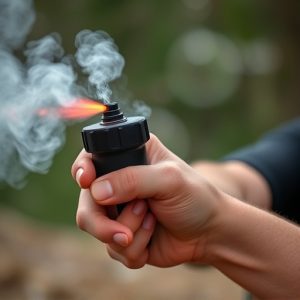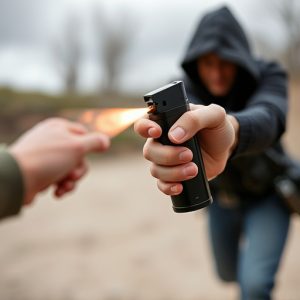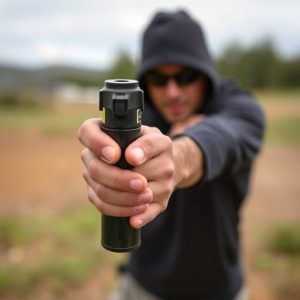Pepper Spray & Eye Washing: Best Practices for Riot Control Safety
TL;DR:Pepper spray, used in riot control, can cause severe eye irritation. The Pepper Spray Eye Wash…….
TL;DR:
Pepper spray, used in riot control, can cause severe eye irritation. The Pepper Spray Eye Washing Procedure involves rinsing eyes with clean, cool water for 15 minutes, blinking frequently, and seeking medical attention if symptoms persist. Riot control officers must be trained in this procedure, use proper protective equipment, and follow best practices for deployment to ensure safe and effective operation while minimizing health risks.
In today’s world, pepper spray stands as a pivotal tool in riot control, offering a non-lethal means to subdue and disperse crowds. This article delves into the intricacies of this powerful substance, focusing on its composition and effects. We’ll guide you through the essential Pepper Spray Eye Washing Procedure, ensuring safety for both officers and individuals affected. Additionally, we explore critical safety precautions and best practices for riot control officers, emphasizing responsible and effective use.
- Understanding Pepper Spray: Its Composition and Effects
- The Eye Washing Procedure: Step-by-Step Guide
- Safety Precautions and Best Practices for Riot Control Officers
Understanding Pepper Spray: Its Composition and Effects
Pepper spray, a common tool in riot control and law enforcement, is a powerful substance designed to incapacitate individuals temporarily. Its primary active ingredient is capsaicin, the same chemical that gives chili peppers their heat. This compound stimulates nerve endings in the eyes, nose, and throat, leading to temporary blindness, difficulty breathing, and intense pain. The spray’s composition also includes various solvents and additives to enhance its effectiveness and ensure proper delivery.
When used during riots or violent situations, pepper spray can quickly disperse crowds by causing non-lethal harm. However, it’s crucial to understand that the effects can be severe, especially for individuals with respiratory conditions or those who have had previous eye injuries. The Pepper Spray Eye Washing Procedure is a critical step in mitigating these risks. It involves promptly irrigating the eyes with clean water for at least 15 minutes to flush out the irritant and alleviate symptoms.
The Eye Washing Procedure: Step-by-Step Guide
Pepper Spray Eye Washing Procedure: A Step-by-Step Guide
In the event of exposure to pepper spray during riot control or similar situations, immediate and thorough eye washing is crucial to minimize irritation, discomfort, and potential long-term damage. The following steps outline a recommended eye washing procedure after coming into contact with pepper spray.
1. Remove Glasses or Protective Wear: If wearing glasses or any protective eyewear, carefully take them off to ensure water can reach the eyes directly.
2. Rinse with Clean Water: Hold your head under a steady stream of clean, cool running water for at least 15 minutes. Ensure that water flows over both eyes and the area around them, flushing out any remaining pepper spray residue. If no running water is available, use bottles or eye wash stations designed for this purpose.
3. Blink Frequently: As you rinse, blink your eyes frequently to help remove irritants from the surface of the eyes and stimulate tear production, which can further aid in flushing out pepper spray chemicals.
4. Seek Medical Attention if Necessary: After thorough rinsing, assess any residual symptoms like stinging, redness, or pain. If irritation persists, seek immediate medical attention to ensure no serious eye damage has occurred.
Safety Precautions and Best Practices for Riot Control Officers
Riot control officers play a crucial role in maintaining public safety during chaotic situations, but their work comes with significant risks. When employing inflammatory spray, also known as pepper spray, it’s imperative to prioritize officer safety and minimize harm to civilians. Proper training on the eye-washing procedure is essential; officers should be equipped to handle accidental exposure immediately. This includes having access to clean water sources for thorough eye rinsing, as well as knowing the correct techniques to ensure effective decontamination.
Best practices dictating safe distances, timing of deployments, and targeting specific individuals can mitigate risks further. Officers must also be prepared with personal protective equipment (PPE) like gas masks or respirators to protect against residual spray and chemical irritants. Regularly scheduled training sessions focusing on these safety precautions are vital to ensure riot control officers remain effective while safeguarding their health and well-being.
Pepper spray, as a key tool in riot control, has both powerful effects and specific safety protocols. By understanding its composition and practicing the correct eye washing procedure, officers can ensure they’re prepared for potential situations while mitigating risks. Adhering to safety precautions and best practices is crucial for effective and responsible riot control, emphasizing the importance of thorough training and ready access to eye washing stations.


